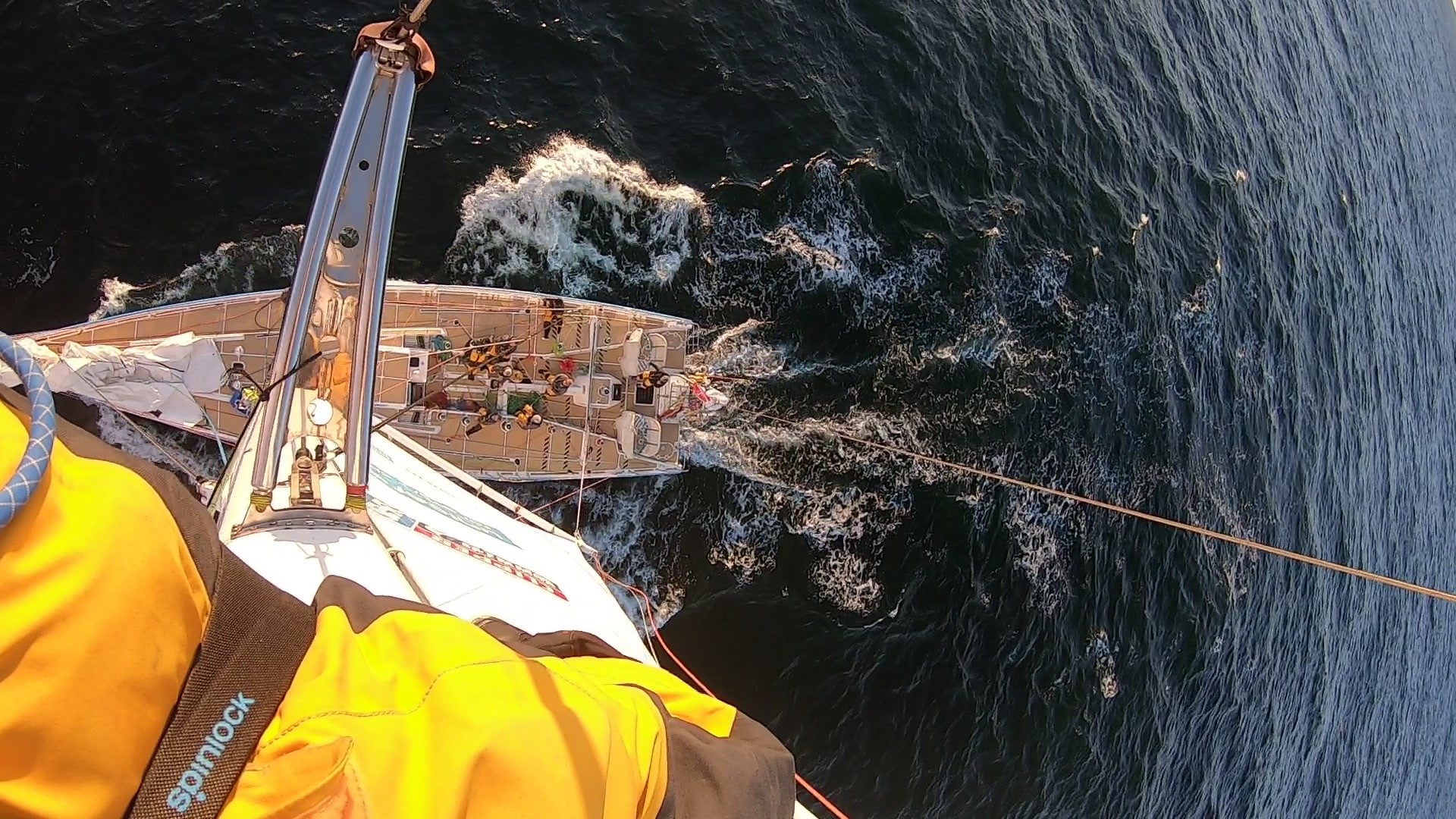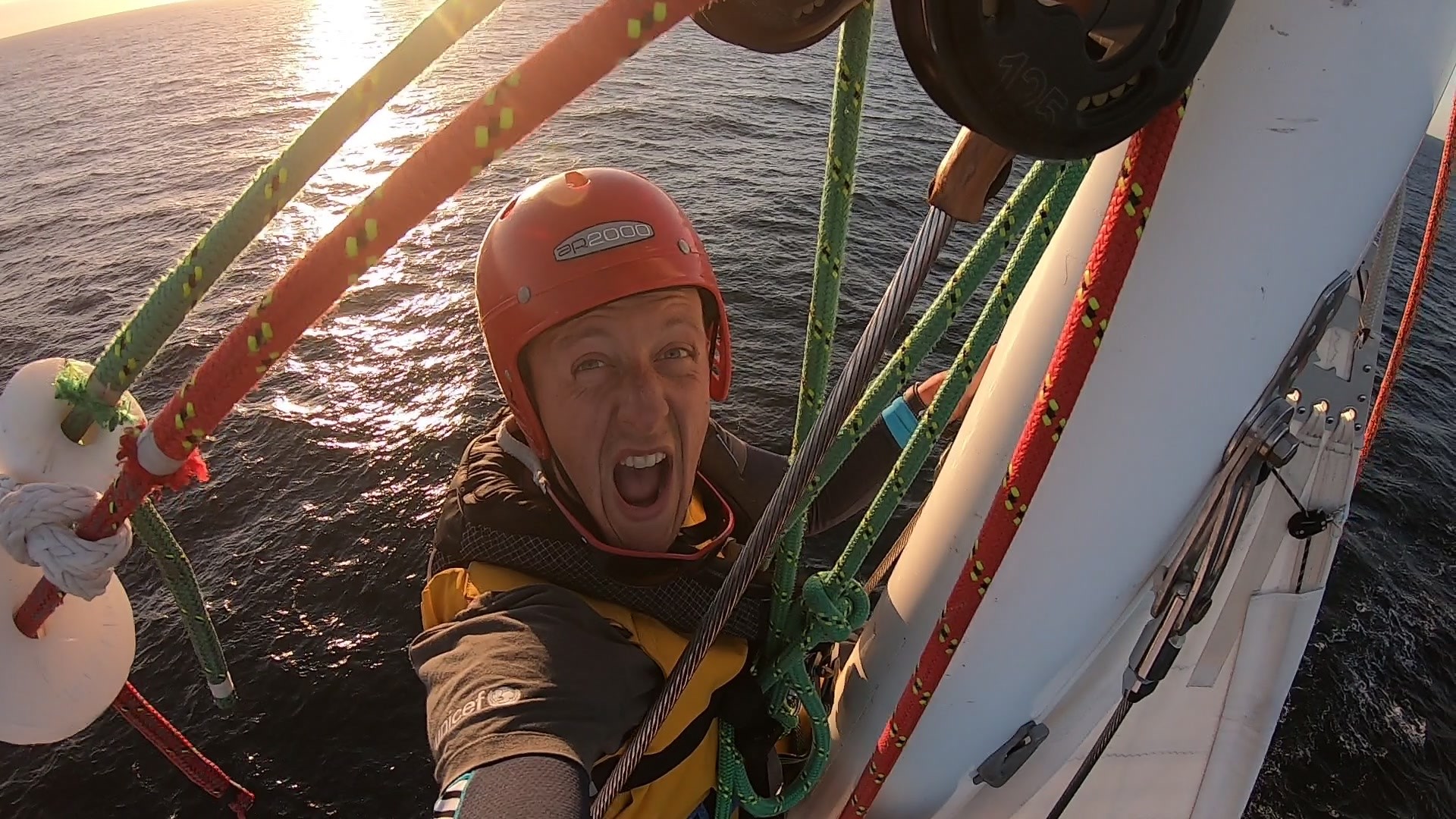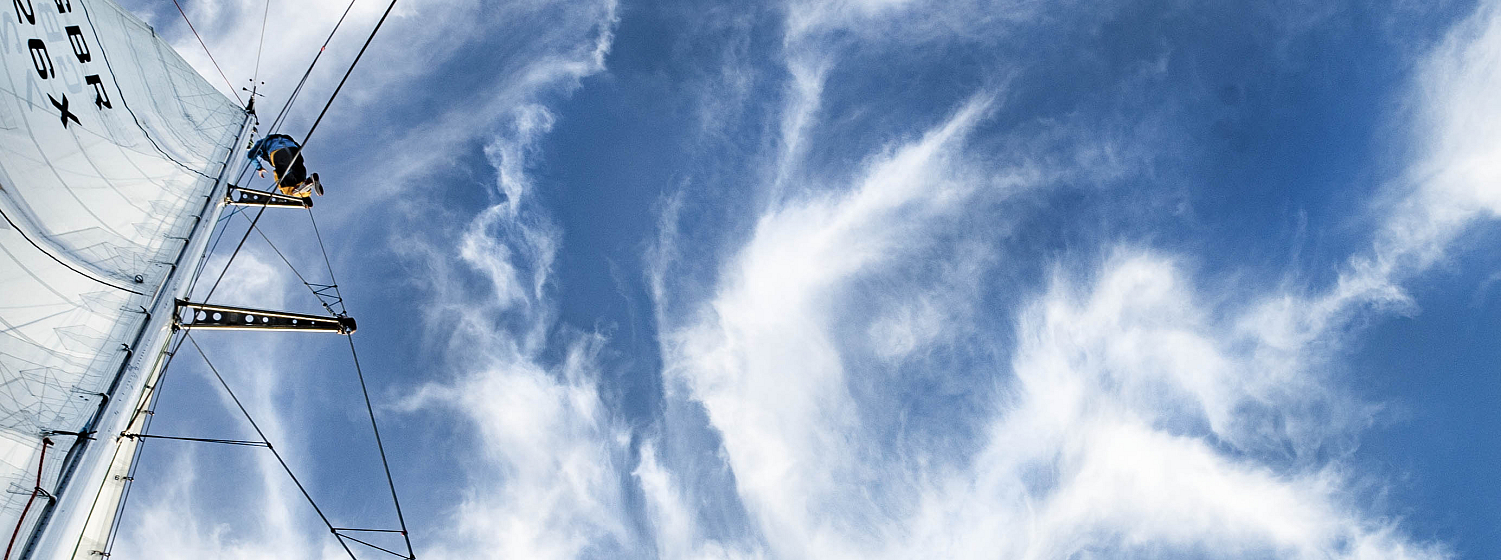Reach for the Sky: Climbing the rig of a Clipper 70
27 May 2021
One of the tasks on board that may polarise Clipper Race Crew, is the need to ascend the lofty heights of the mast. Some thrill seekers on board will jump at the opportunity and others could not be dragged up there by wild horses. It certainly does require a stomach for heights but whoever dares to reach for the sky will be rewarded with breathtaking views and a fresh perspective on life below. A Clipper 70 shrinks to toy-boat size from 25 metres up.
So, is going up the mast a purely thrill-seeking venture? Certainly not. There are many intricate parts that all work together and everything from the deck upwards is referred to as the “Rig”.
This includes the mast, boom, running rigging supplied by Marlow Ropes, Sta-Lok supplied standing rigging, hardware, navigational equipment including Garmin sensors and Hyde Sails.
All of these intricate components require regular inspection both when offshore and in port, as every component needs to be maintained and checked to keep the yacht running safely and efficiently.
When in port, each Clipper Race team is required to carry out a full rig inspection within 36 hours of arrival. This will alert the team to any maintenance issues that need to be remedied. A fully comprehensive checklist is used for this purpose and needs to be signed off by the Skipper. This inspection goes from masthead to deck and covers every single fitting, connection and component in great detail.
When offshore, the risk of going up the rig is greatly increased because of the motion of the yacht as it sails. For every metre you travel up from the deck, the motion increases drastically. Ascending the rig at sea can make even someone with a cast iron stomach seasick. Due to the challenge of climbing a mast, experiencing pendulum motion, routine inspections are not carried out daily at sea. However, daily deck level inspections of the rig and its components are required.
If the conditions permit, an off deck inspection should be carried out at any opportunity because any problems spotted early could prevent the failure of a component. There are, however, entire passages where this may not be possible because of sea state and the Skipper must assess whether it is prudent to leave the deck.

There are times when you may be forced to ascend the rig in less-than-ideal conditions to remedy an issue but these times are kept to a minimum and are one of the reasons a thorough in-port inspection is carried out. Such inspections would normally be carried out by a Skipper or First Mate, due to their high levels of training and experience at sea.
One of the more routine reasons for ascending the rig offshore however, is during times of spinnaker work. During long runs under spinnaker, it is wise to regularly swap the halyards to prevent chafe. This can be avoided by hoisting the spinnaker on two halyards, but this is not always easy or ideal. If the spinnakers are being peeled and gybed regularly, there may also be a need for unwrapping halyard twists, but fortunately this type of spinnaker work usually goes hand in hand with benign conditions.
Clipper Race Crew Fernando (Nano) Antia Bernardez circumnavigated on board Liverpool2018 in the 2017-18 edition and returned to complete Leg 1 and represent his home country of Uruguay on board Punta del Este in the Clipper 2019-20 Race.
Speaking of what it feels like to climb the rig of a Clipper 70 in the middle of an ocean he said. “Being up the top of the mast is like surfing a building or being up the top of a tree in the middle of the sea. Up there you can see the earth is round and with the clouds reflecting on the water and creating shadows, it feels like you are sailing in a 18th century watercolor painting.
“In easy conditions it's an absolute pleasure going up but in rough seas, with a spinnaker flying and doing 18-25 knots, everything changes. Going up there becomes a dangerous, exciting and heart firing moment. It is a team effort. The helm tries to keep a steady course, avoiding collapsing the sail. The team in the cockpit have your life in their hands while they keep sailing the boat. You are up there alone, usually busy doing some work but at the same time experiencing huge amounts of adrenaline and happiness flowing through your body. It’s a superb feeling!”
Whatever the reason, ascending the rig is a potentially hazardous activity, both for the person working at height and the crew working on deck, therefore all Clipper Race Crew, Skippers and First Mates have to adhere to strict safety procedures.
The Skipper must first assess the feasibility of any mast ascent, and the suitability of the mast climber’s physical abilities, with regard to the prevailing conditions. It may be necessary to calm the motion of the yacht by heaving to or turning to a different point of sail before sending anyone aloft.
A climbing harness with two halyards tied on, is used to ascend the mast with internal mast halyards used for the primary ascent line. Crew members on deck will work closely together to winch the person aloft using the chosen primary and secondary halyards, and also ease them down during the descent.
Communication is key to safely control the ascent and descent whilst the person is working and performing the needed checks or fixes above deck. The person ascending must wear a helmet and when climbing the mast at sea, a safety tether or similar is used to assist the climber to remain in contact with the mast and prevent loss of control from any pendulum motion.

While a crew member is working at height, the Skipper ensures no one is standing beneath the mast due to the hazard of falling objects. Furthermore, any tools or equipment taken aloft need to be securely attached to the mast climber by means of a lanyard. And when tools or equipment with no suitable lanyard attachments are to be taken up high, the lanyard is generously taped to the item to ensure nothing is dropped to the deck.
Whilst all Clipper Race crew must undergo four levels of intensive training before joining the race, ascending the mast is not a requirement. Opportunities, however, (and when safe to do so), are provided during training to those crew who wish to climb high, test their fear, see the uppermost rig components firsthand and get a whole new perspective on the Clipper 70 below.
If you find yourself leaving the deck for a rig inspection when racing, you may have to push your fears to the back of your mind but you will be accomplishing a vital task to the efficient, safe running of the yacht and perhaps be rewarded by being the first to spot land after a long ocean passage!
Join The Race